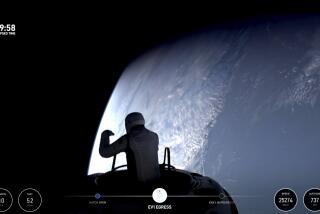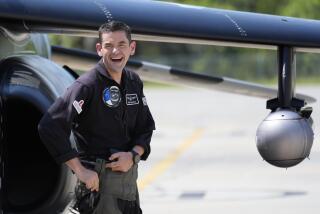CRENSHAW : Boys Group Sees Launch of Shuttle
The experience was very nearly out of this world.
Hal and Bettye Walker and their young charges--21 boys ages 7 to 15--witnessed the launching last week of a space shuttle at Kennedy Space Center in Florida.
The sound and fury of Discovery’s rocket engines proved excitement enough, but the experience was especially rewarding because the group was seeing off a friend--Dr. Bernard Harris, an astronaut who later in the mission became the first African American to walk in space.
The Walkers’ Crenshaw-based nonprofit group, African American Male Achievers Network (A-MAN), was invited by Harris last month to take front-row positions for the historic launching.
A-MAN is a program that introduces boys to a host of professions and disciplines. Its guiding principle is versing black youth in positive options and exposing them to role models. Many A-MAN members are part of the Science Discovery and Learning Center also founded by the Walkers in the Crenshaw district.
The Walkers founded the science center in June as a way of ensuring that African American youths don’t get left behind by the fast-paced science revolution. The La Brea Avenue office is outfitted with computers, educational videos, experimental equipment and other materials largely donated by aerospace and other companies.
For Walker, a retired laser scientist whose innovative devices aided astronauts on the famous 1969 moon voyage, witnessing the launch was a long-deferred dream finally realized.
“It came alive for me,” he said of the experience. “It was like watching another step we’re taking in history.”
During their six-day trip, the A-MAN members also visited the U.S. Space Camp, a hands-on museum that offers children a simulated space trip.
But the unquestionable highlight of the visit was seeing off Harris, who invited the group to the launching two years ago when he spoke at an A-MAN event.
The group has been to several shuttle landings at Edwards Air Force Base and even flew to Florida on one occasion to witness a shuttle launch, but a long delay forced the Walkers and their crew to return home without accomplishing their mission.
Though Harris is not the first African American astronaut to fly in the shuttle, he is the first to walk in space, helping to lay the groundwork for a planned space station. His eight-day mission, in which he studied the effects of space on human metabolism and development, concluded last week.
Walker said the trip was far more than a diversion from city life.
“This (space technology) is a new boat, and we as black people can’t miss it,” said Walker with customary enthusiasm. “They don’t need anybody to sweep the space station. If you’re not prepared for it, if you’re not educated, you miss out.”
More to Read
Sign up for Essential California
The most important California stories and recommendations in your inbox every morning.
You may occasionally receive promotional content from the Los Angeles Times.










